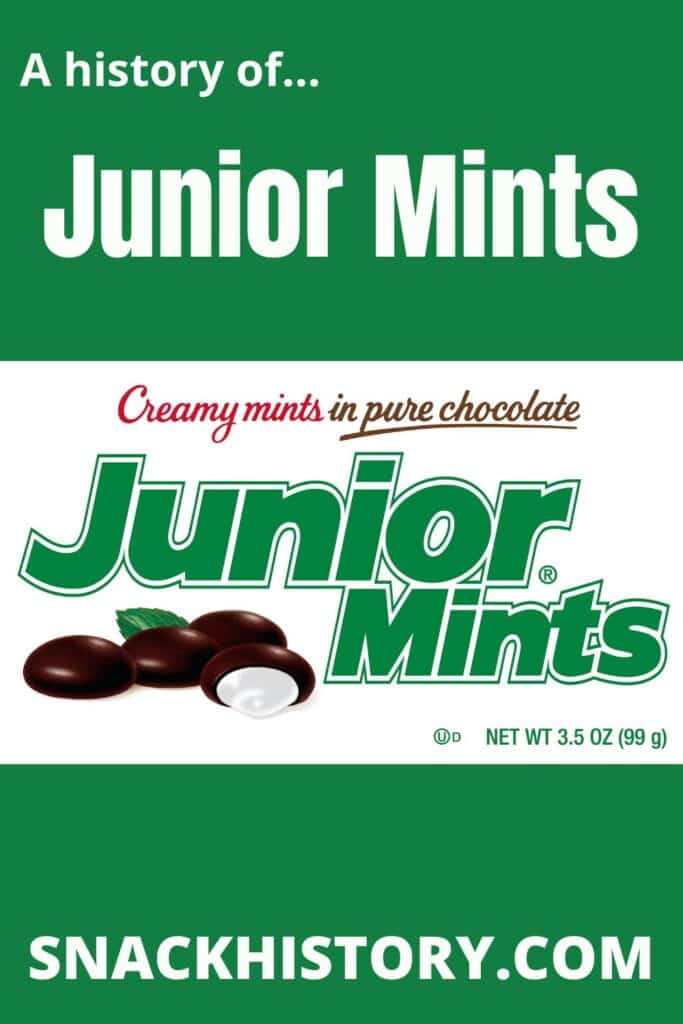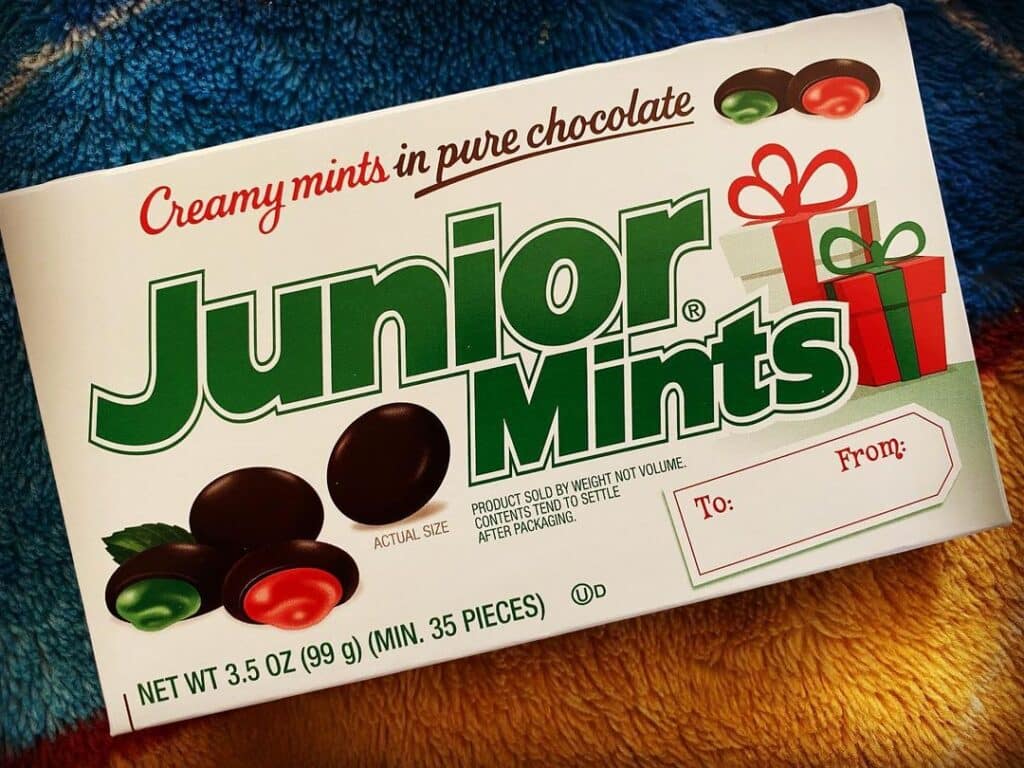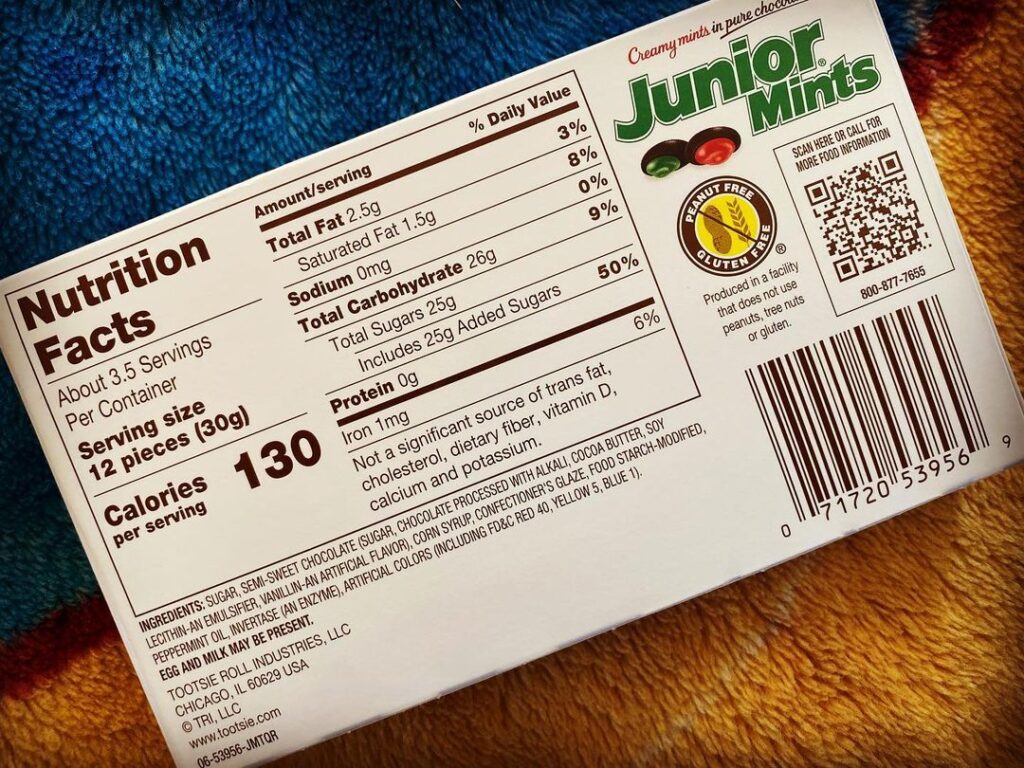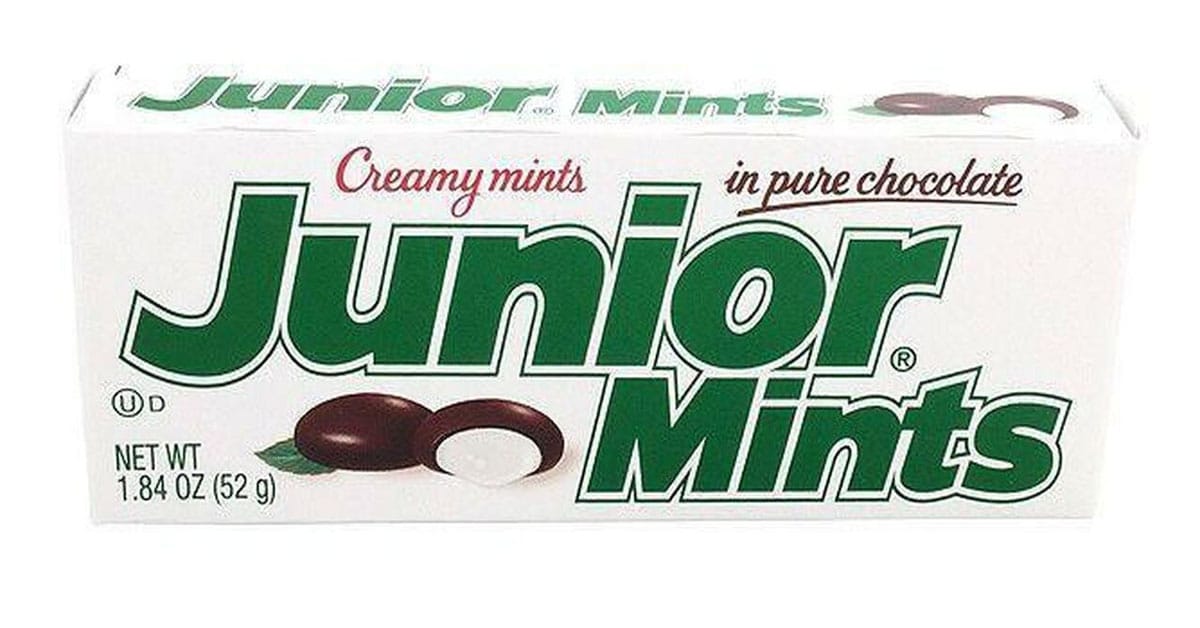Junior Mints – Mouthwatering Chocolate Covered Peppermint Candy
Junior Mints, the nation’s favorite chocolate-covered creamy mint was launched in 1949. This was a time when people with a sweet tooth required both the rich flavor of dark chocolate and the crisp, fresh flavor of peppermint. The pure chocolate-covered candy has long been a favorite of movie theaters and home entertainment enthusiasts. It was named after a then-popular Broadway production called Junior Miss.
If you are obsessed with Junior Mints and want to learn more about their history, this article will provide you with all the necessary and interesting information.
Please leave a review or any memories of this snack in the comments at the bottom of this page. Thank you!

History
The James O. Welch Company, located in Cambridge, Massachusetts, launched Junior Mints in 1949. The business also produced candy bars and candies such as Pom Poms, Welch’s Fudge, and Sugar Babies. For the James O. Welch Company, Charles Vaughan, a seasoned food scientist and one of the creators of pan chocolate, created Junior Mints and Sugar Babies. Charles Vaughan was commissioned by James Welch to create a little chocolate-dipped fondant peppermint.
James O. Welch began his candy firm, Cambridge, in 1927 after graduating from the University of North Carolina and being born in Hertford, North Carolina. Robert W. Welch, Jr., his brother, was his business partner. Robert W. Welch, Jr., created the John Birch Society in 1957 after retiring from the candy industry in 1956.
The brand was purchased by Nabisco in 1963, which was then sold to Warner-Lambert Company in 1988. Warner-Lambert Company then sold the brand to Tootsie Roll in 1993. Junior Mints are still produced today in Cambridge’s Area 4 at a Cambridge Brands facility, a division of Tootsie Roll Industries.
Manufacturing Facility
The Cambridge neighborhood of Boston was informally known as the nation’s confectionery center at the beginning of the 20th century. According to the Boston Globe, 66 separate businesses ran facilities in the Cambridge region by 1946, with many of them congregating in a place known as Confectioners Row. One such building was built in 1927 for the James O. Welch Company. Production of Junior Mints started in 1949.
In the latter decades of the 20th century, as the confectionery business got more corporatized and consolidated, more and more factories closed or relocated to the point where Cambridge Brands was the sole remaining firm from Cambridge’s heyday. And yet, the Cambridge plant continues to create every one of the chocolate-coated mints.
The factory, which employs only 200 people and rarely admits visitors and tours, not only produces Junior Mints but also the majority of the world’s Sugar Babies and Charleston Chew. Each day, over 26.5 million pieces of candy, including 14.56 million Junior Mints, come off the production line.
Packaging
In the 1970s, Nabisco did some intriguing things with Junior Mints packaging, offering a variety of unique wrappers and boxes to collect. It would be hard to locate one of them these days, much less an entire set; yet, someone may have a few stashed away in a closet.
Logo

Variations
Every day, more than 15 million Junior Mints are created. Additionally, Tootsie Roll produces limited-edition “Inside Outs” and Junior Caramels, which have a milk chocolate covering over a caramel filling. Easter Pastels, Christmas Edition, Valentine’s Day Pastels, Valentine’s Regulars, and Christmas Peppermint Crunch Edition are some of the other limited-edition Junior Mints.
Since Junior Mints continue to do well at movie theaters, they are offered in a variety of sizes, from fun-size boxes to movie theater-size boxes. Junior Mints have been consumed all over the world. The Orthodox Union has officially recognized them as kosher.
Junior Mints Deluxe, a sibling product from Tootsie Roll, debuted in 2009. The “Deluxe” is a bigger dark chocolate-covered mint that is foil-wrapped. It is offered in boxes of 10, 22, and 72 pieces with a fold-up sign, which is intended for single-piece sale on store countertops.
Behind the Name of Junior Mints
The name “Junior Mints” fits the product perfectly, it’s catchy and jovial, but also rather literal as the candy consists of tiny bits of mint that have been covered in chocolate. However, Junior Mints’ name is really a play on that of a long-gone, largely forgotten pop culture phenomenon. It wasn’t chosen by the brand’s developers to be as straightforward and informative as possible.
The creators of Junior Mints assert that James O. Welch, the head of original producer the James O. Welch Company, personally named the treat after “Junior Miss,” a well-liked Broadway play based on a collection of widely read New Yorker stories by Sally Benson. The drama was performed for two years, from 1941 to 1943, and was then turned into a radio program with Shirley Temple as the lead.
The popularity of “Junior Miss” had long ago peaked by 1949, the year Junior Mints were introduced. However, consumers of the time likely grasped the humor in the candy’s name, maybe having their memories of the play stirred by the appearance of Junior Mints at concession stands at movie theaters.
How Is Junior Mint Made
Mint and chocolate go well together. However, junior mint is nothing like any other sweet. To induce the sugar to crystallize, corn syrup and sugar are first combined, heated, immediately cooled, and left alone before being vigorously agitated and swirled. This results in a goop that is crystalline and liquid in certain ways.
The frappe, a frothy, marshmallow-like combination of sugar, corn syrup, gelatin, and egg protein, is then added to the mixture. By this point, a mainly fluid, mint-flavored white substance is transported to rubber candy molds that form individual half-spheres, and the proteins in the frappe retain the structural integrity of the sugar crystals.
The sweet solution can set and firm up as it passes through a cooling chamber on a conveyor. This is mostly due to the sugar molecules continuing to crystallize. Once the mints have hardened, they are transferred to a tumbler and repeatedly sprayed with liquid chocolate until they are completely covered.
The Junior Mints get a coating of confectioners’ glaze, which gives the candy its unique sheen, after sitting throughout the next day to allow the chocolate to harden.
Junior Mints in Pop culture
In a Seinfeld episode titled “The Junior Mint,” Junior Mints take center stage. Jerry declines Kramer’s offer of a Junior Mint as they watch Roy, Elaine’s ex-boyfriend, undergo surgery. Kramer subsequently claims, “Who would refuse a Junior Mint? It’s excellent and has peppermint and chocolate.” The two unintentionally drop it into the abdomen’s receded chamber below.
Jerry contacts the hospital to confess the entire scenario as Roy’s health worsens, only to learn that Roy’s condition has improved. The doctor says the patient’s amazing recovery was caused by something beyond science, possibly something from above. Because Junior Mints couldn’t be recorded because of their size, a York Peppermint Pattie was really used. Aaron and Barry spend the whole “The Junior Mints” episode of Fancy Boys trying to get an endless supply of Junior Mints.
The greatest lover of Junior Mints is YouTuber Justine Ezarik. She had Junior Mints memorabilia as a youngster, including a lunch box, t-shirts, and a blanket. She still loves it, but she isn’t as enthused about it now.
A chapter titled “Mint Threshold” in the 2006 book Possible Side Effects by Augusten Burroughs details the author’s experience developing an advertisement for Junior Mints.
Lawsuits & Controversies
The size of a lot of snacks and candy packaging, especially movie theater-size boxes of sweets, makes consumers believe they’re going to purchase a huge amount of candy. The containers are susceptible to “slack-fill,” which simply means that there is a lot of air within, to protect the goods inside or because the products can shift during delivery.
U.S. District Judge Naomi Reice Buchwald heard a case in 2018 in which Tootsie Roll Industries was accused of engaging in dishonest business practices. Because 35 to 43% of the Junior Mint boxes that the plaintiffs Biola Daniel, Abel Duran, and Trekeela Perkins bought included air. They believed that they had overpaid for the candy they received and filed a lawsuit alleging fraud.
Judge Buchwald dismissed the case altogether in a 44-page ruling, concluding that there was no fraud since a buyer of Junior Mints could have determined precisely how much candy was in the box by reading the product’s weight, which was prominently displayed on the label. In Buchwald’s words, assuming that a rational consumer would disregard the data obviously before him imparts to consumers a level of ignorance that the court cannot allow.
Ingredients
- Sugar
- Semi-Sweet Chocolate (Sugar, Chocolate Processed with Alkali, Cocoa Butter, Soy Lecithin-An Emulsifier, Vanillin-An Artificial Flavor)
- Corn Syrup
- Confectioner’s Glaze
- Food Starch-Modified
- Peppermint Oil
- Invertase (An Enzyme)
Nutrition
| Serving Size: | 16 pieces (40g) | % Daily Value* |
| Amount Per Serving | ||
| Calories | 168 | |
| Total Fat | 6.3g | 8% |
| Saturated Fat | 3.8g | 19% |
| Polyunsaturated Fat | 0.2g | |
| Monounsaturated Fat | 1.6g | |
| Cholesterol | 0.3mg | 0% |
| Sodium | 8.7mg | 0% |
| Total Carbohydrates | 30g | 11% |
| Dietary Fiber | 1.4g | 5% |
| Sugars | 24g | |
| Protein | 1.2g | |
| Potassium | 82.5mg | 2% |
- The % Daily Value (DV) tells you how much a nutrient in a serving of food contributes to a daily diet. 2000 calories a day is used for general nutrition advice.
Pictures


Commercials
Bottom Line
The delicacy known as Junior Mints features tiny rounds of mint filling encased in a dark chocolate shell that has a dimple on one side. Currently, Tootsie Roll Industries manufactures the product, which comes in a variety of sizes, from the fun-size box to the considerably bigger one.
In this article above, we explored the history and facts about Junior Mints candy. Those amazing candies managed to stick around and have maintained the love and adoration of young and old alike today.

Nato is a content writer and researcher with a background in psychology. She’s passionate about writing about the candy industry and exploring the cultural significance of sweets and treats. She believes that the stories behind our favorite snacks can reveal a great deal about our values.
Please leave a review or any memories of this snack in the comments below. Thank you!
Click here for a full A-Z list of Snacks and Candy
